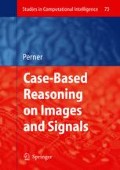Graphs are a powerful and universal tool widely used in information processing. Numerous methods for graph analysis have been developed. Examples include the detection of Hamiltonian cycles, shortest paths, vertex coloring, graph drawing, and so on [5]. In particular, graph representations are extremely useful in image processing and understanding, which is the complex process of mapping the initially numeric nature of an image (or images) into symbolic representations for subsequent semantic interpretation of the sensed world.
Access this chapter
Tax calculation will be finalised at checkout
Purchases are for personal use only
Preview
Unable to display preview. Download preview PDF.
References
P. Perner, Data Mining on Multimedia Data, Springer, Berlin 2002
K. Fukunaga: Statistical Pattern Recognition, Academic Press, Inc., San Diego, 1990
O.R. Duda, P.E. Hart: Pattern Classification, Sec.. Edition. J. Wiley, New York, 2001
R.A. Johnson, D.W. Wichern: Applied Multivariate Statistical Analysis, Prentice-Hall, Inc., Englewood Cliffs, New York, 1991
Bobrowski L., Topczewska M., Improving the K-NN classification with the Euclidean distance through linear data transformations, pp. 22–32 in: ICDM 2004, Eds. P. Perner et al., Lipsk, Germany, Springer Verlag 2004, Springer Lecture Notes in Artificial Intelligence 3275
L. Bobrowski, M. Topczewska: “Linear visualising transformations and convex, piecewise linear criterion functions”, Bioc. and Biom. Eng., pp. 69–78, Vol. 22, Nr.1, 2002
L. Bobrowski: “Design of piecewise linear classifiers from formal neurons by some basis exchange, Pattern Recognition, 24(9), pp. 863–870, 1991
L. Bobrowski, H. Wasyluk, Diagnosis supporting rules of the Hepar system, pp. 1309–1313 in: MEDINFO 2001, Eds: V. L. Petel, R. Rogers, R. Haux, IOS Press, Amsterdam 2001
Bobrowski L.: Eksploracja danych oparta na wypukłych i odcinkowo-liniowych funkcjach kryterialnych (Data mining based on convex and piecewise linear (CPL) criterion functions) (in Polish), Technical University Białystok, 2005
Author information
Authors and Affiliations
Editor information
Editors and Affiliations
Rights and permissions
Copyright information
© 2008 Springer-Verlag Berlin Heidelberg
About this chapter
Cite this chapter
Jiang, X., Bunke, H. (2008). Graph Matching. In: Perner, P. (eds) Case-Based Reasoning on Images and Signals. Studies in Computational Intelligence, vol 73. Springer, Berlin, Heidelberg. https://doi.org/10.1007/978-3-540-73180-1_5
Download citation
DOI: https://doi.org/10.1007/978-3-540-73180-1_5
Publisher Name: Springer, Berlin, Heidelberg
Print ISBN: 978-3-540-73178-8
Online ISBN: 978-3-540-73180-1
eBook Packages: EngineeringEngineering (R0)

